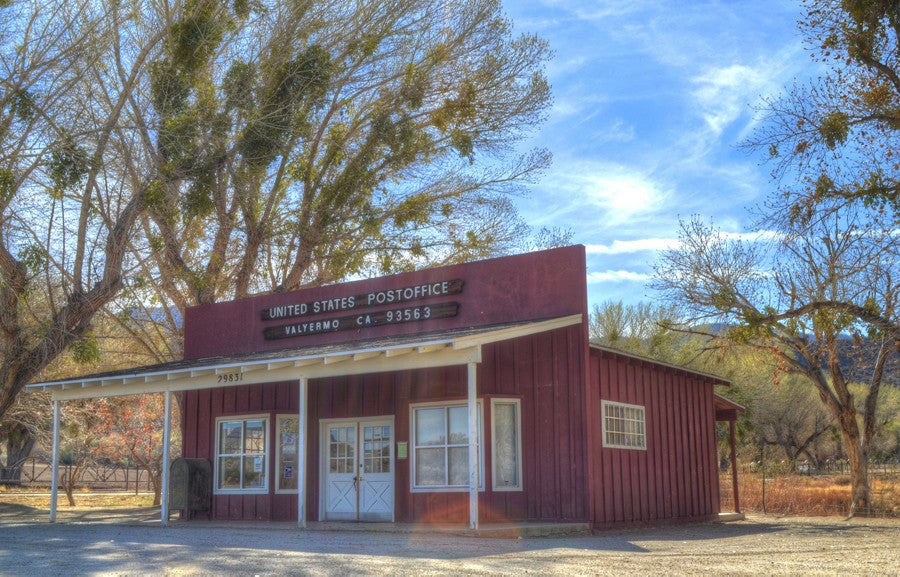Ask a Thru-Hiker: How Do I Get Get Food on the Trail?

'Post offices can be your best friends when it comes to feeding yourself. (Photo by William Garrett'
This is Ask a Thru-Hiker, where record-setting long-distance hiker Liz “Snorkel” Thomas answers your questions about life on the trail.
Dear Snorkel,
How on Earth do through hikers carry enough food for a six-month trek? I’ve been on some long backpacking trips, but start collapsing under my pack’s weight if I have to carry more than 7 days of food. Those thru-hikers aren’t eating squirrels, are they?
Hungry Hiker
Dear Hungry Hiker,
Fear not—If your dream is to finish a long trail, there’s no need to develop a taste for small, furry creatures.
Like you, no thru-hiker wants to carry more than 7 days of food unless he or she really has to. Over a 2,000 mile trip, a typical thru-hiker will resupply dozens of times in small towns near the trail. Most long distance trails in the U.S. are routed through the heart of a few settlements, though at times, adventurers may need to walk, bus, or catch a ride from trailheads to nearby communities to re-up food and gear.
Resupplying during a long hike is an art that gets easier with knowledge, experience, info and practice, but can never truly be perfected. There’s a lot of factors to control for and a lot to mess up: What about my food allergies? How do I avoid having my resupply points be more than a week apart? Is it even possible to find vegetarian food in Wyoming?
There are a few ways thru-hikers resupply, including buying food and supplies from stores in trail towns and asking a friend or family member to meet you. But one of the best, and sometimes cheapest, ways to resupply is to simply ship a package to your next stop.
You don’t need a P.O box to send yourself mail. Instead, you can send a package to the next post office on your route, and they’ll hold it until you show up (with ID) to pick it up. It’s called General Delivery Service, and while it’s not available at some post offices in major cities, it’s fairly common in rural areas. Your friendly neighborhood post office will allow you to send a package—addressed to yourself—to another post office where you can pick it up with proof of ID. It’s called General Delivery service. While it’s not available at many POs in major cities, it is still common in rural areas, and it makes thru-hikers’ lives much easier: I’ve always thought the Post Office should have sponsored thru-hikers instead of cyclists, since we depend so heavily on their service.
For most people, having a support crew meet you at every road crossing is unreasonable. Instead, most thru-hikers end up using a hybrid of the other two options: sometimes receiving packages of supplies, sometimes buying from local grocery and gear stores. Which option hikers gravitate toward depends on which they find more annoying: eating gas station food or waiting around for the mail.
On some long trails, you may haveno other option than to send yourself a package. Some areas along your hike may be so remote that they don’t have a grocery or gear store locally.
If you are getting your food from packages, you may need to have a loyal friend or family member at home send them to you. Make sure to give your at-home support crew the detailed list of where, when, and how to send your boxes.
Otherwise, you can mail yourself food from a large city along the trail to a minor trail town that has nothing locally. Many PCT thru-hikers opt to buy lots of food from the major grocery store in Mt. Shasta, CA and send it to the Post Office in the very small town of Seiad Valley, California. This strategy works especially well for foreigners hiking in the U.S.
No matter how you resupply, you will have to interact with other humans. Despite some thru-hikers’ greatest wishes, a long hike isn’t just 6 months in the woods by yourself. So take note: regardless of how hungry you are or how far you have walked, it’s important to stay civil and friendly when interacting with the folks who live near the trail. After all, chances are you won’t be the only thru-hiker walking into town looking for a shower and a meal. It’s best to leave locals with good feelings about hikers so that others can continue to enjoy the town’s services
And if everything else goes down the tubes, there’s always the squirrels.
Snorkel